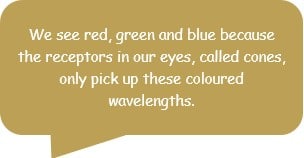Do we all see the same thing?


Complementary Colours and Grey
In 1810, Goethe published a book of scientific colour observations. His main findings below are from this video series.
Goethe observed that looking through a prism at a window with bars, there was a halo of colours between the boundary of the bars and white light.

He showed that light’s primary colours are blue, green and red. When these colours overlap at a boundary, he observed complimentary light colours.


This modern light diagram is the same as Goethe’s findings.
He also observed that if you look at a primary coloured cube for a while and then close your eyes, you will still see the same cube but in complementary colours. Try it.




He also noticed that grey adapts to its surrounding colour. The same grey looks darker in a white background and lighter in black background.
In the early 20th century Munsell developed the scientific understanding of colour which is still used today. This diagram explains his 3D model, made up of four components to describe each colour.

What Do We Really See?
Light from images goes through a lens to the back of our eyes and is detected by cones. The red and green cones overlap which is why colour-blind people often cannot tell these colours apart.


Our cones in our two eyes receive slightly different upside-down images of the object. The visual cortex part of our brain flips these two images upright and interprets the nerve impulses sent from the eyes into a single 3D image.
Everyone’s brain processes what they perceive uniquely. Recent studies suggest that what one person sees as red might be perceived as blue by someone else.
People’s eyes receive the same colour wavelengths when they look at an object.
Everyone’s brain might process the nerve impulses from their eyes differently, so individuals perceive unique colours.
Provided we all share the same name for a colour wavelength, it doesn’t matter how our brains interpret the nerve impulses, we all perceive the same thing.
READ MY NEXT POST TO UNDERSTAND THE SCIENCE BEHIND HOW WE “SEE”
Prism – a triangular glass shape which splits white light into different colours
Wavelength – light travels in waves and different colours of light have more (or less) distance between the waves which is why a prism can be used to separate white light into different colours
Primary colours of light – red, blue and green
Secondary colours of light – yellow, cyan and magenta
Perceive/perception – how our brains interpret information
Britannica Kids. (2020). white light: prism. [online] Available at: https://kids.britannica.com/kids/assembly/view/87682 [Accessed 20 Dec. 2019].
The Scientist Magazine®. (2017). Newton’s Color Theory, ca. 1665. [online] Available at: https://www.the-scientist.com/foundations/newtons-color-theory-ca-1665-31931 [Accessed 19 Dec. 2019].
Youtube.com. (2013). Goethe’s Theory of Colours, Part 1 – How it all started. [online] Available at: https://www.youtube.com/watch?time_continue=43&v=QnfVlENcHbU&feature=emb_logo [Accessed 19 Dec. 2019].
BBC Bitesize. (2020). Colour – Light waves – KS3 Physics Revision – BBC Bitesize. [online] Available at: https://www.bbc.co.uk/bitesize/guides/zq7thyc/revision/6 [Accessed 21 Dec. 2019].
COLOR THEORY?. (2013). MUNSELL COLOR SYSTEM. [online] Available at: https://alexandrapev.wordpress.com/2013/09/09/20/ [Accessed 18 Dec. 2019].
Aeon. (2018). The red and green specialists: why human colour vision is so odd – James P Higham | Aeon Ideas. [online] Available at: https://aeon.co/ideas/the-red-and-green-specialists-why-human-colour-vision-is-so-odd [Accessed 21 Dec. 2019].
How It Works. (2015). Science of vision: How do our eyes enable us to see? – How It Works. [online] Available at: https://www.howitworksdaily.com/science-of-vision-how-do-our-eyes-enable-us-to-see/ [Accessed 22 Dec. 2019].
Wolchover, N. (2012). Your Color Red Really Could Be My Blue. [online] livescience.com. Available at: https://www.livescience.com/21275-color-red-blue-scientists.html [Accessed 19 Dec. 2019].
